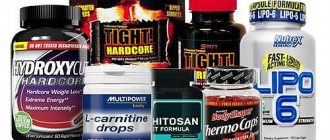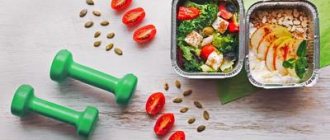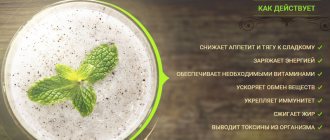Who can use Viit
Someone who is already trained. This method is not for beginners.
What is high-intensity interval training in fitness? Advanced level.
A simple example. Do you know what physical exercises a person who has come to join a special forces unit, for example, the famous “Alpha”, must demonstrate? The applicant must be in very good athletic shape.
He will have to do several sets of complex exercises for strength, endurance and stretching, without stopping or resting. Done - fit for duty! No - go get ready.
Why is that? Because he needs to start intensive training, and his heart is not used to accelerating to 80 percent of its reserve, the body cells are not taught to tolerate short-term oxygen starvation, and the vessels cannot withstand the blood flow pushed through them.
The result (if you don’t stop in time) is fainting. And it’s good if it’s not a stroke or heart attack.
First you need to learn how to perform well on regular exercises. This may take months, but then you can begin to form a beautiful, muscular and toned body.
What are the benefits of high-intensity interval training hiit?
Regular cardio (workouts that moderately increase your heart rate) needs to be done for a long time to force your body to burn off excess fat.
On average, you need to spend about forty minutes on one lesson. At the same time, muscle fibers will also grow slowly. We accustom our body to long-term work, in which large muscle mass even gets in the way.
What are our special forces friends or firefighters doing? They need to accustom their body to make jerks, giving all their best. Therefore, they train with elements of the above method.
The load when using hiit is distributed approximately like this:
- a short interval of maximum effort, such as a sprint;
- three times the interval of regular cardio for recovery;
- another jerk;
- Cardio again.
Jerks can last from several seconds to several minutes. The whole lesson takes from a quarter of an hour to half an hour. You can study three times a week. No longer recommended.
During “breathes”, the body, which has managed to use up glycogen in the jerk, begins to use fat reserves more intensively. The effect is that we are already breathing and breathing evenly, and the body continues to burn the excess.
Circular for weight loss with dumbbells 5 minutes
Circular 1-3 circles
Lunges with dumbbells
- 12-15 per leg
- Body part: Quadriceps Equipment: Dumbbells
Squats with dumbbells
- 1 set of 25-30 repetitions
- Body part: Quadriceps Equipment: Dumbbells
Push ups
- 1 set of 15-20 repetitions
- Body Part: Chest Equipment: No
Back lunges into scissors with weight
- 10-12 per leg
- Body part: Buttocks Equipment: Dumbbells
Plank with alternate arms
- 12-15 per hand
- Body Part: Press Equipment: No
Add to Calendar * Add to My Workouts * Print Workout
* — The service is in beta testing
Each exercise can be further complicated at your request for additional impact on the muscles. Look carefully at our tips for each movement to find your own approach to losing weight in 10 minutes a day.
Lunges in place with dumbbell lifts
Take a pair of 2-3 kg dumbbells, stand in a wide step (one leg in front, the other behind). Hold the dumbbells at a level just above your shoulders, with your elbows bent. Lean forward slightly, bend your knees, lowering yourself into a lunge position. After this, focusing on your front leg, straighten up, lifting the dumbbells above your head. Next, return to a lunge and lower the dumbbells to your shoulders. Repeat 12-15 times for each leg, change stance.
Lunges with dumbbells
Squats with dumbbells raised in front of you
Hold dumbbells or suitable weights in both hands and lower them loosely at your sides. Take a squat position and at the same time raise your arms in front of you to a horizontal level. Keep your back straight and don't lean forward. If you experience discomfort, reduce the amplitude to a half squat. Return to the starting position and lower your arms. Repeat the movement 25-30 times maintaining the technique. Your position at the bottom point should be similar to the illustration below.
Push-up with dumbbell lift
Take the same position as when doing a push-up, but lean not on your palms, but on dumbbells, and your arms should be straight. Begin to slowly lower your body and bend your arms, then rise up again with outstretched arms and lift one of them off the floor, bending at the elbow and transferring your body weight to your supporting arm, and hold in this position for a few seconds. Do the same with the other hand. Repeat 10-15 times. This is a great short arm and core workout for girls.
Back scissor lunges with dumbbell curls
Stand straight, feet shoulder-width apart, hands with dumbbells hanging freely below. Take a step back with your left foot, curtseying (scissors), and bend your right leg at the knee. While in this position, lift the dumbbells toward your shoulders onto your biceps, bending your elbows. After this, take a step back and take the starting position. Repeat the same for the other leg. Perform the exercise 10-12 times on each leg. Your buttocks, legs and arms will thank you.
Alternating lifting of legs and arms from plank position
Assume a plank position with your arms straight. Lift one leg off the floor, keeping your hips and shoulders in line. After this, straighten your leg and lift it up as high as you can without arching your back. Take the starting position and repeat the same with the other leg. Lift one arm off the floor, keeping your body and arm in line. Return to the starting position and repeat the same with the other leg. Do 12-15 repetitions on each leg and arm.
Plank with alternate arms
All exercises can be further complicated to suit your taste and you can add short interval cardio training outdoors to improve fat burning results.
What does too intense training lead to? What is gastrointestinal syndrome
Scientists from Australia have described in detail the gastrointestinal syndrome that occurs when running too much. How does it develop? During grueling races, the walls of the gastrointestinal mucosa are damaged. As a result, so-called leaks from the intestines into the bloodstream occur. When bacteria enter the bloodstream, they can cause acute illness, including blood poisoning.
If you think about it, this effect is quite understandable. Our intestines are home to a huge number of microorganisms, some of which are toxic. Scientists have found that up to 3 kg of bacteria live in the body of a healthy person! This collection of human microbes is called microbiota. Being in their natural environment, that is, on the intestinal walls, they do not pose a threat. Once in the circulatory system, they can be hazardous to health.
What else can excessively intense training lead to? These are malabsorption (poor absorption of nutrients in the small intestine), deterioration of intestinal motility, constipation, and diarrhea.
For a healthy person, heavy loads do not pose a big threat, especially since marathons and supermarathons are the destiny of a small number of people. But if you have been diagnosed with irritable bowel syndrome, then it is worth reconsidering your training program. Especially if you prefer to run.
Intense exercise in hot weather is harmful
Ricardo Costa argues that high ambient temperature is an additional factor that increases damage to the gastrointestinal mucosa. To confirm his hypothesis, the nutritionist conducted an experiment in which 10 people took part: 6 men and 4 women. He did a randomized crossover study. This means that all participants went through the same tests. Volunteers alternately performed work on a treadmill in three temperature modes: a treadmill in three temperature modes: moderate (22.2 degrees Celsius), warm degrees Celsius) temperature modes: modes: moderate (22.2?), warm (30.4? ) and hot (35.3?).
Before the load, during it and after the test, blood was taken from all participants in the experiment. This was how the amount of protein I-FABP, which binds fatty acids, changes. It is by the content of this substance in the blood that one can understand whether there is destruction of the intestinal walls. In addition, the participants' rectal temperature was measured using special equipment.
As a result, the scientists found that the level of I-FABP protein rose the highest (by 454%) during exercise at a hot temperature. At the same stage, the subjects had the highest rectal temperature. Scientists have concluded that intense training in hot climates contributes to damage to the intestinal mucosa. Therefore, runners who perform in the heat are at risk of digestive system disorders. Below we will tell you how you can avoid them.
CHEST EXERCISES
EXERCISE 1. “WALL PUSH-UPS”
Performing the exercise “Push-ups from the wall”
The body is straight, inclined, arms are widely spaced slightly below the shoulder line, palms are parallel to each other in a circle. Bending your elbows, approach the wall and then smoothly push up from it, trying to do this minimally with your arm muscles and maximally with your pectoral muscles. During push-ups, the elbows go to the sides and do not fall down. Repeat 10 times.
EXERCISE 2. “HAND SCISSORS”
Performing the exercise “Scissors with hands”
Standing straight, arms spread as far as possible to the sides (feel the stretch in the pectoral muscles), palms pointing down. Connect your hands crosswise in front of you: first one hand on top, then repeat - the other. Perform slowly, be sure to consciously strain and stretch the pectoral muscles. Repeat 30 times.
EXERCISE 3. “CIRCULAR SWINGS”
Performing the exercise “Circular swings”
Standing straight, with both arms slightly bent at the elbows, perform synchronized swings with maximum amplitude: first forward (as in butterfly swimming), then back (as in backstroke swimming). Repeat 15 times in each direction.
Note: A set of exercises for weight loss that replaces a full workout!
How can an athlete maintain gut health?
The dietary supplement "Mesi-Vit Plus" will help you stay in good shape and compete for sports awards. It is produced from the roots of elecampane using cryoprocessing technology, unique to our country. This method allows you to convey to the consumer all the beneficial substances and properties of the plant. The drug effectively improves the secretory function of the stomach and intestines. It also has a positive effect on blood circulation in the mucous membrane, which will allow you to go through intense training without any health consequences. Let us also note other valuable properties of the supplement: choleretic, bile-forming, anthelmintic, sedative.
Let us add that plant fiber is a natural prebiotic that helps remove waste and toxins from the body and reduces cholesterol levels.
When producing the drug, we do not use the extract, but the entire plant. Thanks to this, you get prebiotic - fiber and natural vitamins contained in elecampane. With Mesi-Vit Plus, maintaining intestinal health has become very simple.
The dietary supplement also includes vitamin C, which has a powerful antioxidant effect. This means that with this drug, recovery after training will be faster. "Mesi-Vit Plus" is simply irreplaceable for everyone who has chosen the path of a professional athlete!
There is another remedy that will help you maintain gut health. The dietary supplement “Senna D” is created from senna leaf powder and elecampane rhizome powder. This is an excellent opportunity to solve the delicate problem of constipation, which is familiar to many athletes. Note that the drug has proven itself well against dysbiosis, irritable bowel syndrome, and chronic colitis.
IIT Basics
While IITs are designed to push the boundaries of your capabilities, this fat-burning workout at home or at the gym will take you far beyond your comfort zone for a period of time. When making an IIT plan, you need to focus on four important things: duration, intensity, frequency and length of the recovery interval.
In general, an exercise interval should last between 5 seconds and 8 minutes at an intensity that is 80 to 95 percent of your maximum heart rate if you are using that as a guide, or 9 to 10 on the Perceived Exertion Scale (PES). that is, subjectively felt tension.
The rest time between intervals depends on your fitness level and goals.
If you're already quite advanced, you can try a 2:1 work-to-rest ratio. This means that the rest is shorter than the working set, meaning after a 1 minute sprint you rest for 30 seconds.
For a less intense workout, you can take a 1:2 ratio, that is, you work out for 30 seconds and then rest for 1 minute.
Or you can make work intervals the same as rest intervals.
With that in mind, here are 5 different fat-burning interval workouts that are suitable for anyone. But before you start, there are a few things to keep in mind.
How to do the workout
The workout consists of six exercises:
- 20 jumps “legs together - legs apart” (Jumping Jacks).
- 20 air squats.
- 10 jumping burpees.
- 20 times - exercise "bicycle".
- 20 jumping lunges (10 on each leg).
- 10 push-ups with arm and leg raises.
As soon as you finish one exercise, move on to the next without rest. When you do the latter, rest for one minute and then start over. You need to do five laps in total.
Does everyone need intense training?
Sports achievements are given to athletes with great difficulty. More often than not, we see only the bright side of this phenomenon. The fight for medals often leads to injuries and illnesses. Too intense training depresses the reproductive system and can disrupt the menstrual cycle in women.
It is also worth remembering frequent flights, the need to adapt to a different climate and diet. It is not surprising that as a result of this lifestyle, the body wears out prematurely. Ricardo Costa's research is another trump card for opponents of professional sports.
At the same time, moderate physical activity helps to get rid of many diseases of the gastrointestinal tract, including gastric ulcers. If you don't set yourself sky-high goals in sports, then you don't necessarily need to spend more than an hour in the gym. Even short sessions will have positive health effects. English doctor Mike Mosley proved that just three minutes of exercise a week can improve your physical fitness. And short but intense workouts will help you with this.
We do not encourage anyone to quit sports. An athlete's career provides an opportunity for self-realization and develops character. Is it worth sacrificing your health for the opportunity to stand on a prize podium? Let everyone decide for themselves. We suggest you use natural remedies to avoid illnesses during training and competitions.
High-intensity interval training made easy
Few trained people know that when they are completely exhausted in the mass race “Forward to a heart attack!”, a kind of “second wind” opens. It's simple: first we burned all the glycogen, then the body tensed up and gave us strength, starting to burn fat.
In a trained long-distance athlete, this transition occurs almost imperceptibly; the body is accustomed to working in a similar mode.
The Viit principle is an artificial introduction of oneself into a “second wind”. A short and intense workout burns the entire muscle energy reserve - after which the body seeks to replenish the balance by burning fat during the rest period. This is impossible with classic cardio. The fat-burning effect stops the moment the workout ends.
That's all!
TJ Custer, strength and conditioning coach:
When a client says that he has no time at all, I prescribe the following training:
Warm-up: 6 minutes Without warming up, it reduces the risk of injury and helps to work technically in the main part. I prefer Racine's warm-up.
Muscle Activation: 2 minutes A couple of sets of band stretches and band walks help prepare the shoulder and pelvic girdle for action.
Explosive activation of the central nervous system: 2 minutes
Throw the medicine ball at the floor to activate the nervous system.
Circuit – back squat, push-up, pull-up on a low bar: 10 minutes
In these three exercises, do the maximum number of sets of 10 repetitions in 10 minutes. This circuit training balancedly develops almost all the muscles of the body, increases strength endurance and strengthens the cardiovascular system.
Source: t-nation.com Translation: Alexey Republicommando
Subscribe to our telegram channel, and may the force be with you
Read on Zozhnik:
What to do if your back hurts
The science of posture: why it is important to maintain it and how to train it
4 squat myths debunked by science
Best Back Exercises: ACE's Own Research
Orthopedist-traumatologist - about dangerous exercise equipment, cumulative and running injuries, menisci, cases from practice











